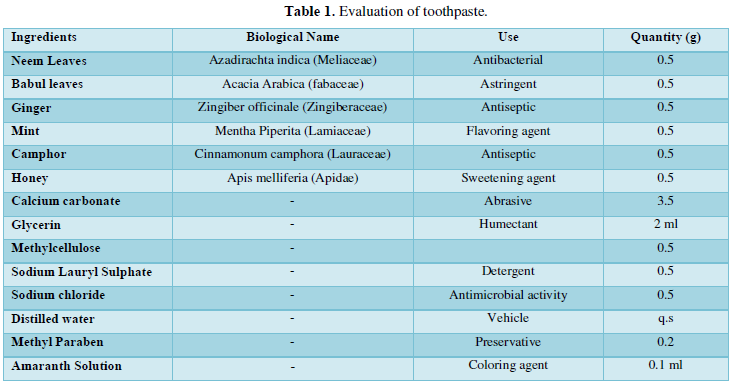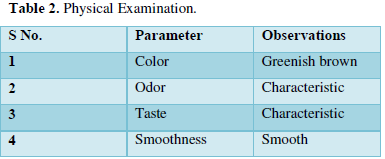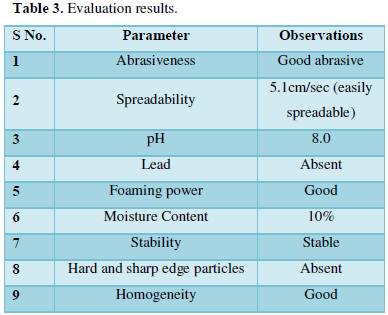5771
Views & Citations4771
Likes & Shares
This work was carried out to prepare and evaluate an herbal toothpaste which can be used as a tool for proper oral hygiene and to overcome the side effect of the conventional toothpaste by synthetic ingredients. Neem (Azadirachta indica), babul (Vachellia nilotica or gum arabica tree), and Amrud (Psidium guajava or Guava) are the herbal ingredients that are used to formulate herbal toothpaste which can satisfy all the required properties. The prepared toothpaste was evaluated for its Organoleptic and physical characteristics to ensure that it possesses all the desired features to use against dental diseases. The result was found to be within permitted limits.
Keywords: Herbal toothpaste, Evaluation, Oral hygiene
- Color: The prepared toothpaste was evaluated for its color. The color was checked visually [1,2,5,7,8].
- Odor: Odor was found by smelling the product [1,2,5,7,8].
- Taste: Taste was checked manually by tasting the product [1,2,5,7,8].
- Smoothness: The Smoothness was tested by rubbing the paste formulation between the fingers [1,2,5,7,8].Determination of sharp and edge abrasive particles: To check the presence of any sharp or tight particles 15-20 cm. Dismiss long-length material on fingers and butter paper. Repeat the same process for at least 10 times. No sharp or firm particles were found [1,2,5,7,8].
- Determination of Spreadability: Take one gram of toothpaste placed on a glass slide (10 x 10 cm) and cover it with another glass slide. Then keep the weight of two kilos on the covered glass slide (not sliding). After 3 minutes the spread of toothpaste (cm) is measured. Repeat the experiment and took the average value of the three lectures [1,2,5,7,8].
- pH determination: 150 grams of beaker had 10 grams of toothpaste. Boiled and then add 10 ml of cold water. Strong enthusiasts to suspend predicted the pH of the suspension using a pH meter [1,2,5,7,8].
- Determination of lead: The color produced with a sample solution containing hydrogen sulphide is compared with a standard lead solution [1,2,5,7,8].
- Foaming power: Take a suspension of the material in measuring cylinder, shaken the suspension for 12 times and measured the volume of the foam produced after shaking for 5 min.
-
Procedure: Weighed 5 grams of toothpaste in 100 ml of the beaker. Add 10 ml of water and cover the glass beaker with a glass of glass and put it aside for 30 minutes. If present, heat dissolving gradually to dissolve the detergent. Transfer 250 ml cylinders by moving suspension with a glass rod. If no foam is prepared, inspection (more than 2 ml). Add 5-6 ml of water and transfer the remains in the beaker to measure the cylinder. Then make up the cylinders with 50 ml of water. 30s Move content with the movements above to get a uniform suspension on after pushing, keep the cylinder aside and keep it for 5 minutes. And the last tip foam + water tones [1,2,5,7,8].
Calculation
% By mass =100 M1 / M
M1 - loss of mass (in grams) on drying
M - Mass (in grams) of the material taken for the test
- Determination of moisture and volatile matter: 6-8 cm Sample 5g in diameter and 2-4 centimeters of porcelain dish in the room. Dry the sample at 1050C in the oven [1,2,5,7,8].
- Stability study: The toothpaste should be stable, but not to be deteriorating, ferment and segregate during normal storage conditions and usage. The stability of toothpaste can be tested when it exposes to 45±20C for 28 days. After storage, no phase separation, fermentation, and gassing can be observed. Also exposed to refrigerator conditions such as 2-80C for 24 h, no obstruction of extrudable form from the container is observed [1,2,5,7,8].
- Homogeneity: The toothpaste shall extrude a homogenous mass from the collapsible tube or any suitable container by applying normal force at 27±20 Also, the bulk of contents shall extrude from the crimp of the container and then rolled it gradually [1,2,5,7,8].



- Mamatha D, Kumar VN (2017) Preparation, Evaluation and Comparison of Herbal Toothpaste with Markedly Available Tooth Pastes. IOSR J Pharm Biol Sci12(6): 1-6.
- The History of Toothpaste and Toothbrushes. Bbc.co.uk. Retrieved on April 4, 2013.
- Siswomihardjon W, Badawi SS, Nishimura M (2007) The difference of the antibacterial effect of neem leaves and stick extracts. Int Chin J Dent 7: 27-29.
- Sharma pp (2008) Cosmetics: formulation, manufacture, quality control, 7th edn, Pardana publication Pvt Ltd. pp: 507-519.
- Pavan D, Roshan T, Mahendra G (2017) Formulation and Evaluation of Herbal Toothpaste: Compared with Marketed Preparation. Int J Pharm Drug Anal 5(10): 406-410.
- Madhumitha M, Chandrika M, Prahlad SP (2013) Evaluation of the Safety and Efficacy of Complete Care Herbal Toothpaste in Controlling Dental Plaque, Gingival Bleeding and Periodontal Diseases. J Homeo Ayurv Med 2(2): 1000124.
- Mangilal T, Ravikuma M (2016) Preparation and evaluation of herbal toothpaste with commercial herbal toothpastes: An in-vitro study. Int J Ayurv Herb Med 6(3): 2266-2273.
- Grace XF, Darsika C, Sowmya KV, Azra A, Shanmuganathan (2015) Preparation and evaluation of herbal dentifrice. Int Res J Pharm 6(8): 509-511.
- Mithal BM, Saha RN (2000) A Handbook of Cosmetics’, Vallabh Prakashan, 1st pp: 204-208 & 217-221.
- Neema RK, Rathore KS, Dubey BK (2009) Textbook of Cosmetics. CBS Publishers & Distributers, 1st pp: 194-195.
- Nanda S, Nanda A, Khar RK (2006) ‘Cosmetic Technology’, Birla Publications, 1st pp: 438-442.


